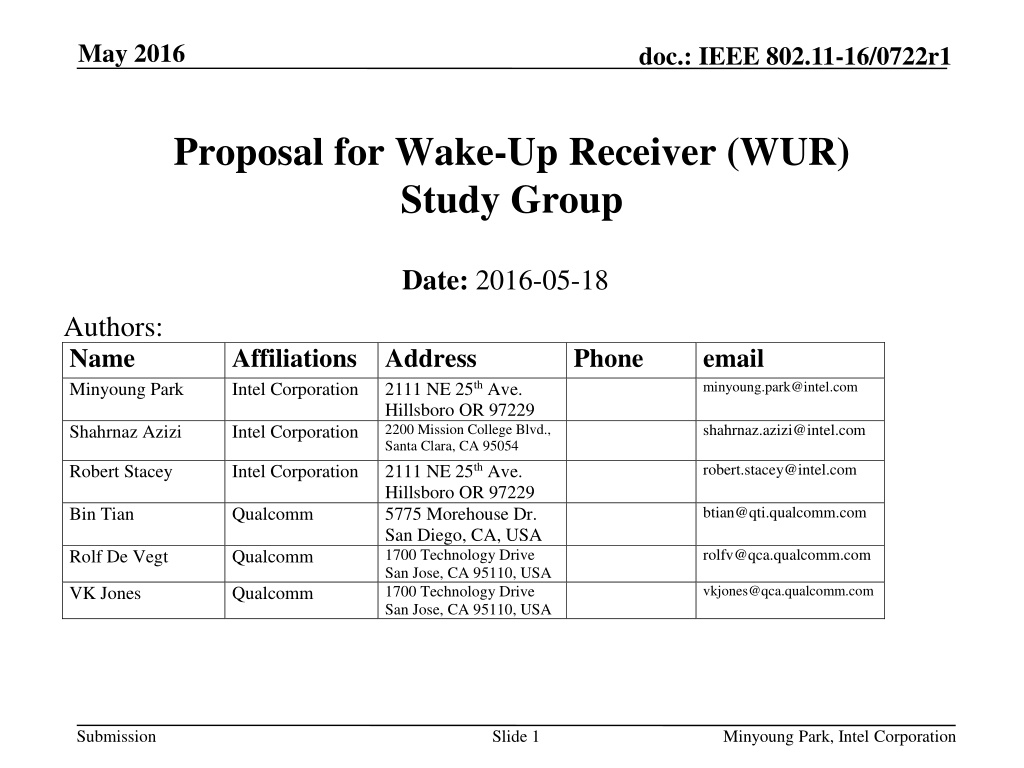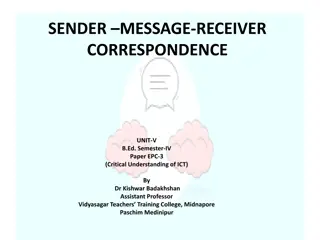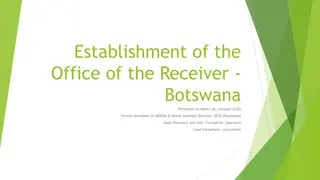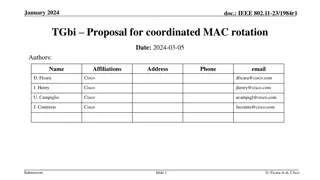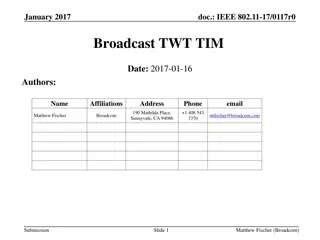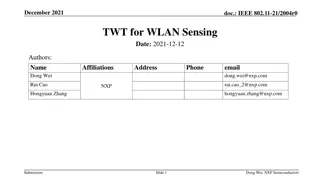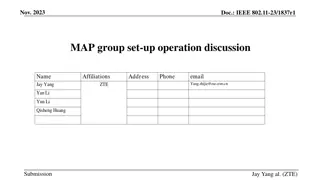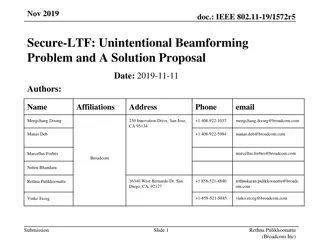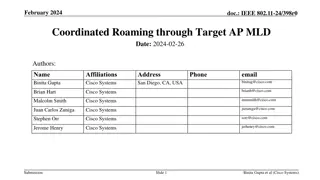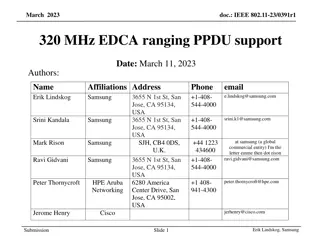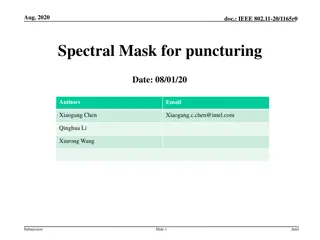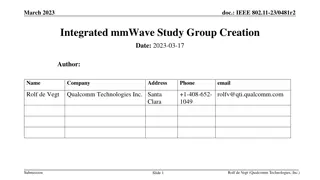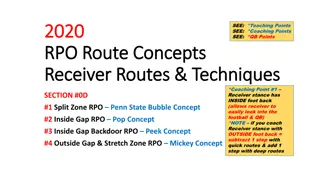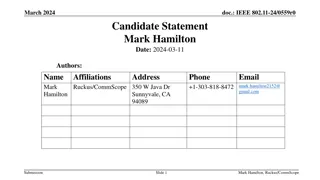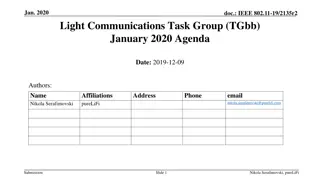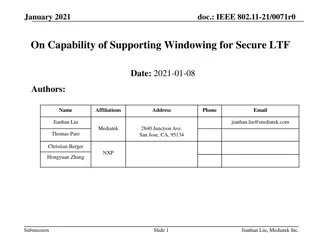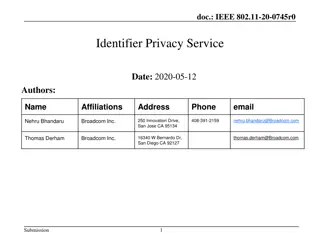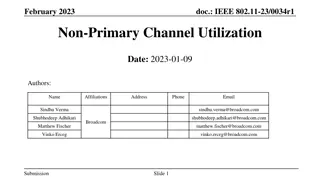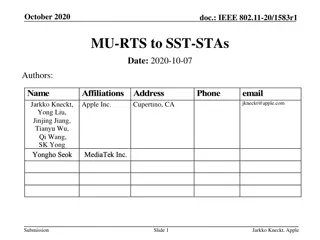Proposal for Wake-Up Receiver (WUR) Study Group in IEEE 802.11-16
The document presents a proposal for the creation of a Wake-Up Receiver (WUR) Study Group within the IEEE 802.11-16 standard. The WUR technology aims to enable energy-efficient data reception without increasing latency, with a defined scope of work and feasibility. The proposal outlines the need for a Study Group, defines the scope of work, and targets a quick implementation of a WUR-related amendment. The document also includes references and a straw poll result supporting the formation of the Study Group.
Download Presentation

Please find below an Image/Link to download the presentation.
The content on the website is provided AS IS for your information and personal use only. It may not be sold, licensed, or shared on other websites without obtaining consent from the author. Download presentation by click this link. If you encounter any issues during the download, it is possible that the publisher has removed the file from their server.
E N D
Presentation Transcript
May 2016 doc.: IEEE 802.11-16/0722r1 Proposal for Wake-Up Receiver (WUR) Study Group Date: 2016-05-18 Authors: Name Minyoung Park Affiliations Address Intel Corporation Phone email minyoung.park@intel.com 2111 NE 25th Ave. Hillsboro OR 97229 2200 Mission College Blvd., Santa Clara, CA 95054 2111 NE 25th Ave. Hillsboro OR 97229 5775 Morehouse Dr. San Diego, CA, USA 1700 Technology Drive San Jose, CA 95110, USA 1700 Technology Drive San Jose, CA 95110, USA shahrnaz.azizi@intel.com robert.stacey@intel.com btian@qti.qualcomm.com Shahrnaz Azizi Intel Corporation Robert Stacey Intel Corporation Bin Tian Qualcomm rolfv@qca.qualcomm.com Rolf De Vegt Qualcomm vkjones@qca.qualcomm.com VK Jones Qualcomm Submission Slide 1 Minyoung Park, Intel Corporation
May 2016 doc.: IEEE 802.11-16/0722r1 Authors (continued): Name Edward Au Affiliations Address Huawei Phone email edward.ks.au@huawei.com David Xun Yang Huawei David.yangxun@huawei.com Ross Jian Yu Huawei Ross.yujian@huawei.com Yunsong Yang Huawei yangyunsong@huawei.com Submission Slide 2 Minyoung Park, Intel Corporation
May 2016 doc.: IEEE 802.11-16/0722r1 Proposal to Create a WUR SG Why WUR SG? New capability for 802.11 WUR enables energy efficient data reception mode without increase of latency Independent of 802.11 PHY WUR can be used for any existing and future 802.11 PHY amendments (i.e. 802.11 a/b/g/n/ac/ad/ax/ ) Feasibility WUR is well-defined technology with many proof points of feasibility [1] Limited and well-defined scope of work We propose to create a SG for WUR [1] Define a PAR that limits the scope of the work to WUR Target a quick implementation of an amendment for WUR Submission Slide 3 Minyoung Park, Intel Corporation
May 2016 doc.: IEEE 802.11-16/0722r1 Straw Poll Result in WNG this week Do you support the formation of a new 802.11 Study Group to develop PAR&CSD for the LP-WUR technique described in [1]? Y: 79 N: 3 A: 35 Submission Slide 4 Minyoung Park, Intel Corporation
May 2016 doc.: IEEE 802.11-16/0722r1 References [1] IEEE 802.11-15/1307r1, Low-power wake-up receiver for 802.11 [2] IEEE 802.11-16/0027r0, LP-WUR (Low-Power Wake-Up Receiver): Enabling Low-Power and Low-Latency Capability for 802.11 [3] IEEE 802.11-16/0341r0, Low-power wake-up receiver follow-up [4] IEEE 802.11-16/0402r0, LP WUR Wake-up Packet Identity Considerations [5] IEEE 802.11-16/0381r0, Discussion of Wake-up Receivers for LRLP [6] IEEE 802.11-16/1446r12, LRLP Output Report Draft Submission Slide 5 Minyoung Park, Intel Corporation
May 2016 doc.: IEEE 802.11-16/0722r1 Backup Submission Slide 6 Minyoung Park, Intel Corporation
May 2016 doc.: IEEE 802.11-16/0722r1 Background November 2015 LP-WUR (low-power wake-up receiver) [1] was introduced to WNG and received strong support for standardization in the 802.11 WG Result of the following straw poll in [1]: Do you support the basic concept of the LP-WUR technique in this presentation for standardization in the 802.11WG? Y: 65, N: 1, A: 51 January 2016 The basic concept of LP-WUR was introduced in LRLP TIG [2] March 2016 More technical contributions on LP-WUR in LRLP TIG [3,4,5] (50% of technical contributions) After 6 months of discussion, LRLP TIG did not reach consensus to create a SG during the March meeting The combined target of long-range and low-power prevented narrowing the focus of TIG, which resulted in considering many different use cases and requirements [6] Slide 7 Submission Minyoung Park, Intel Corporation
May 2016 doc.: IEEE 802.11-16/0722r1 Development Times of Previous Amendments It takes a long time to develop an amendment in 802.11WG There are exceptions such as 802.11z and 802.11ae that had a limited and well-defined scope of work Amendments PAR approved (t1) Draft 2.0 (t2) Duration (t2-t1) 802.11ah 2010-10-04 2014-07-05 3 years, 9 months 802.11af 2009-12-09 2012-08-19 2 years, 8 months 802.11ac 2008-09-26 2012-02-18 3 years, 5 months 802.11ad 2008-12-10 2011-04-05 2 years, 3 months 802.11aa 2008-03-27 2010-12-08 2 years, 8 months 802.11ae 2009-12-09 2011-02-18 1 year, 2 months 802.11s 2004-05-13 2008-05-03 4 years 802.11v 2004-12-08 2008-03-15 3 years, 3 months 802.11z 2007-08-22 2008-08-20 1 year 802.11n Reference: http://www.ieee802.org/11/Reports/802.11_Timelines.htm 2003-09-11 2007-03-09 3 years, 6 months Submission Slide 8 Minyoung Park, Intel Corporation
May 2016 doc.: IEEE 802.11-16/0722r1 Proposed Timeline 2016 July: create a LP-WUR SG Define a PAR limited to LP-WUR November: create a LP-WUR TG 2017 May: complete LP-WUR D0.1 November: complete LP-WUR D1.0 2018 May: complete LP-WUR D2.0 Today 2018 2017 2016 6 mo. 6 mo. 6 mo. 4 mo. May Nov. 17 - LP-WUR D1.0 May. 18 - LP-WUR D2.0 July 16 Create a LP-WUR SG Nov. 16 - Create a LP-WUR TG May 17 - LP-WUR D0.1 Submission Slide 9 Minyoung Park, Intel Corporation
May 2016 doc.: IEEE 802.11-16/0722r1 Recap: Low-Power Wake-Up Receiver (LP-WUR) as Companion Radio for 802.11 Comm. Subsystem = Main radio (802.11) + LP-WUR Main radio (802.11): for user data transmission and reception Main radio is off unless there is something to transmit LP-WUR wakes up the main radio when there is a packet to receive User data is transmitted and received by the main radio LP-WUR: not for user data; serves as a simple wake-up receiver for the main radio LP-WUR is a simple receiver (doesn t have a transmitter) Active while the main radio is off Target power consumption < 100 W in the active state Simple modulation scheme such as On-Off-Keying (OOK) Narrow bandwidth (e.g. < 5 MHz) Target transmission range: LP-WUR = Today s 802.11 Submission Slide 10 Minyoung Park, Intel Corporation
May 2016 doc.: IEEE 802.11-16/0722r1 Recap: Design and Operation of LP-WUR Transmission range 802.11 = LP-WUR or Data Packet Receiver Transmitter 802.11 802.11 802.11 802.11 ON OFF ON OFF + 802.11 Wake-up Packet Wake-up signal LP-WUR ON Wake-up Packet Extremely low power receiver design (< 100 uW) - Small and simple OOK demodulator 802.11 preamble for coexistence - Use L-SIG to protect the packet - This is for 3rd party legacy stations - This is not decoded by LP-WUR (L-SIG: legacy SIGNAL field) Payload of wakeup packet modulated with On-Off Keying (OOK) - Payload = [Wakeup preamble | MAC header (Receiver address) | Frame body | FCS] - OOK modulation can be done using OFDM transmitter with modification (OFDM: orthogonal frequency division multiplexing; FCS: frame check sequence) Submission Slide 11 Minyoung Park, Intel Corporation
May 2016 doc.: IEEE 802.11-16/0722r1 802.11 Compatible Wakeup Packet Design Wakeup packet = Legacy 802.11 preamble (OFDM) + new LP-WUR signal waveform (OOK) Legacy 802.11 preamble provides coexistence with legacy STAs 802.11 stations can detect beginning of this packet CRC Wakeup packet may carry other information Receiver address Wakeup preamble (e.g. PN sequence) 802.11 stations know end of this packet Example signal waveform 1bit /1 OFDM symbol period (= 4usec) = 250kbps Wake-up preamble Legacy 802.11 preamble MAC Header + Frame Body + FCS Submission Slide 12 Minyoung Park, Intel Corporation
May 2016 doc.: IEEE 802.11-16/0722r1 Wakeup Packet Generation Using OFDM Transmitter OOK pulse design: Reuse 802.11 OFDM transmitter for OOK pulse generation Example: Subcarrier width = 312.5 kHz, OOK pulse BW = 13 subcarriers (4.06 MHz) s= {13 subcarrier tone sequence} Xt = IFFT(s), followed by 0.8 sec cyclic prefix extension 4us symbol period Submission Slide 13 Minyoung Park, Intel Corporation
May 2016 doc.: IEEE 802.11-16/0722r1 LP-WUR Function LP-WUR receives and decodes a wakeup packet without any help from the 802.11 radio LP-WUR Simple Packet Parser RF/Analog Front-end Digital Baseband Submission Slide 14 Minyoung Park, Intel Corporation
